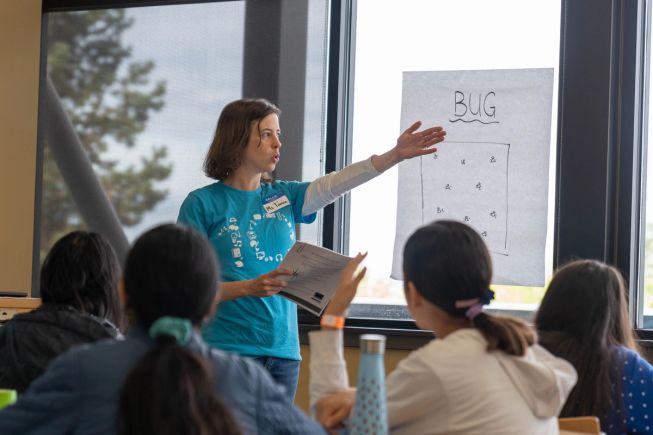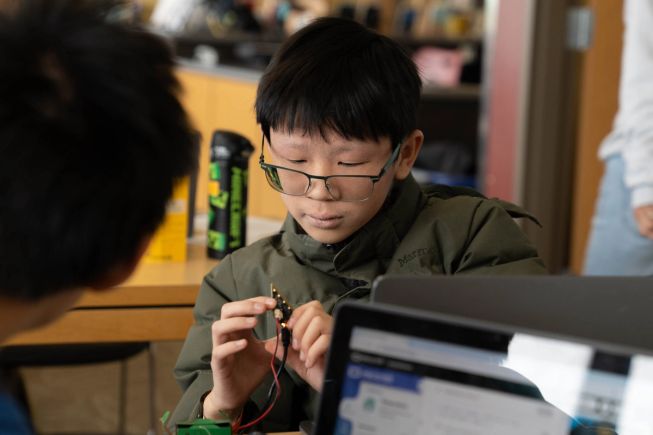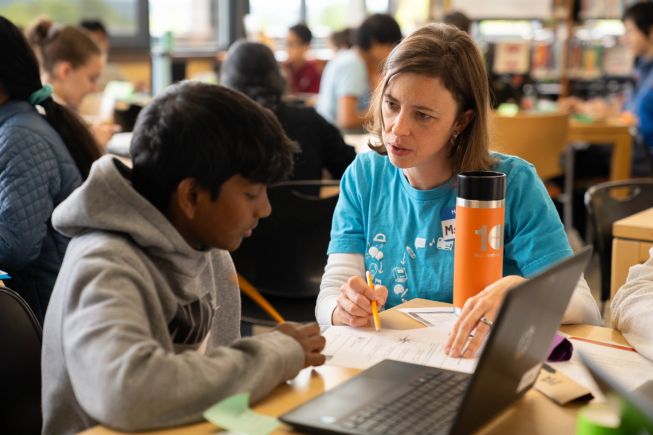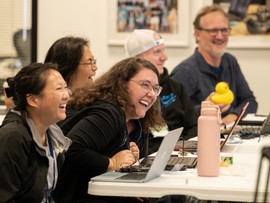3 classroom management strategies for teaching with micro:bit
Tania Dearden from foundry10 shares tips for using the BBC micro:bit while teaching a whole class.

Tania Dearden from foundry10 teaching a whole class about micro:bits
Photo: Wes Koseki, foundry10
Tailoring classroom instruction to meet the needs of individual students while keeping the class engaged as a whole is always a juggle, but can be especially challenging when introducing new technology. Teachers around the world have brought micro:bit into their classrooms to help students learn everything from computing fundamentals to saving sea creatures. Physical computing with micro:bits already offers a "low floor, high ceiling" approach, accommodating different skill and experience levels among students. But to really optimise the versatility of the technology for learning, some intentional planning is required.
Tania Dearden, Education Programs Manager at foundry10, an education research organisation based in Seattle, USA, partnered with the International Community School in the development and facilitation of a three-day “micro:bit Focus Week program” for 30 middle school students. Together, they wanted to ensure all students would be supported and engaged throughout the programme.
“We wanted every student to feel both confident and challenged learning with the technology,” said Tania. To accomplish this goal, Tania and the teachers at ICS used several strategies to plan ahead for the spectrum of interest, skill, and confidence in coding the students would bring to the program. Below, we share some of those strategies for other educators who want to use classroom management to make the most of their micro:bits.
Strategically group your students

“For our micro:bit program, we allowed students to group themselves into groups of either 2-3 with students of similar coding experience. We saw nearly every youth stay engaged throughout the program, and I believe this was in large part because each group was able to work to and push past their unique coding ceiling.”

Tania Dearden, Education Programs Manager at foundry10
Grouping students can enhance peer support, reduce costs for physical computing devices, and ease the teacher's load by having fewer groups to manage. Here are some key factors to consider:
- What size group would work best for your class? The size of groups can impact how engaged youth remain in the activity. Pairs allow more hands-on involvement, but if one partner is absent, the other may have to work alone. Trios can increase the student-to-device ratio, but often result in one student becoming disengaged. It's best to avoid groups larger than three students to maintain engagement.
- What are the levels of expertise and interest? It’s valuable to consider the level of expertise and skill within a group. Pairing novices with experts can promote peer learning, but it may limit the experts' opportunities to develop new skills and leave novices feeling overwhelmed if not properly included. Pairing students of similar skill levels allows them to work at their own pace, but may require more support from the facilitator as each group seeks to work up to their own personal limits.

Photo: Wes Koseki, foundry10
Plan activities for a range of student skill levels
Take an approach that keeps all students involved and maintains students’ interest while allowing them to continue learning at their own pace.
- Choose an entry activity. Start with a basic activity that all students can complete, ensuring they achieve the fundamental learning goals. For example:
- Use the micro:bit classroom tool to provide starter code for students. This pre-written code can be edited to give students a useful starting point for the unique activity you assign. Students often feel more confident getting started on a new concept when they are not faced with a blank screen.
- Offer extension activities: Provide a range of activities that allow students to continue building on the fundamentals. This allows students to advance their learning and stay engaged by choosing projects that interest them.
- Use micro:bit Make it: code it projects to explore a variety of beginner, intermediate, and advanced projects related to different subjects and micro:bit features. Tailor these project ideas to meet the unique interests of your youth or the focus of your classroom.
“Our programme focused on using the micro:bit sensors to explore the classroom and outdoor environments. For each of the four sensors – light, sound, magnetometer (compass), and temperature – we assigned an introductory activity for all groups to complete. Then, we offered a variety of extension challenges for youth to choose from and encouraged youth to create their own challenges to explore the sensor. For example, all groups coded the micro:bit to show the light level detected by the light sensor. Most groups then opted to make more complex devices, coding the micro:bit to sound an alarm at high light levels or to turn on the LEDs when it got dark. This approach fostered youth voice and choice while meeting the learning goals of understanding the strengths and limitations of each sensor,” said Tania.

Tania Dearden, foundry10, works with a student on paper, before working with the laptop
Photo: Wes Koseki, foundry10
Provide multiple sources of support
Managing multiple groups in a micro:bit programme can be overwhelming, especially when several groups need troubleshooting assistance at the same time. To help groups stay productive when the teacher is unavailable, plan ahead with the following support resources.
- Prepare physical support materials. Create a worksheet that outlines the activity and provides links to helpful resources at each stage. Provide a slide deck with coding tips that students can reference. These materials can guide students through common problems and keep them on track.
- Empower peer mentors to advise. Identify students who can serve as peer mentors. These youth leaders can help their classmates, reducing the burden on the teacher and fostering a collaborative learning environment. This approach also makes it easier for some students to ask for help.
- Bring visual progress indicators. Give each group a stack of three cups: red (completely stuck), yellow (a little confused), and green (feeling good). Students can indicate their progress by displaying the appropriate cup colour. This colour-coded system helps the educator quickly identify which groups need urgent support and prioritise their assistance accordingly.
- Utilise micro:bit classroom. micro:bit classroom allows teachers to manage the whole class through one portal. Teachers can use this tool to review each group's code in real time and identify which students may need extra support. You can also review the final projects and reflect on whether the learning goals were achieved.
“micro:bit classroom was an essential part of our programme. It allowed us to give youth space to work on their own while we were able to review the code to see who was struggling and what their challenges were. The visual cup indicators were also super valuable. When several groups needed help at once, I was able to prioritise students who were completely stuck while giving groups that were slightly confused a chance to continue debugging. I could also acknowledge their need for support and let them know when I would come to them, so they didn’t have to keep their hands raised the whole time they were waiting for me,” said Tania.

Photo: Wes Koseki, foundry10
Prepare for the best
Teaching with micro:bit is a rewarding endeavour that has the potential to build young people’s confidence and interest in coding. Preparing ahead of time to support all of your students can ensure everyone stays engaged and learns new skills.
For more useful strategies to implement micro:bits into your classroom, explore this short, self-paced Practical Tips for Teachers using the BBC micro:bit professional development course.
Many thanks to foundry10 for sharing their story. Learn more about Technology, Media, and Information Literacy at foundry10.


